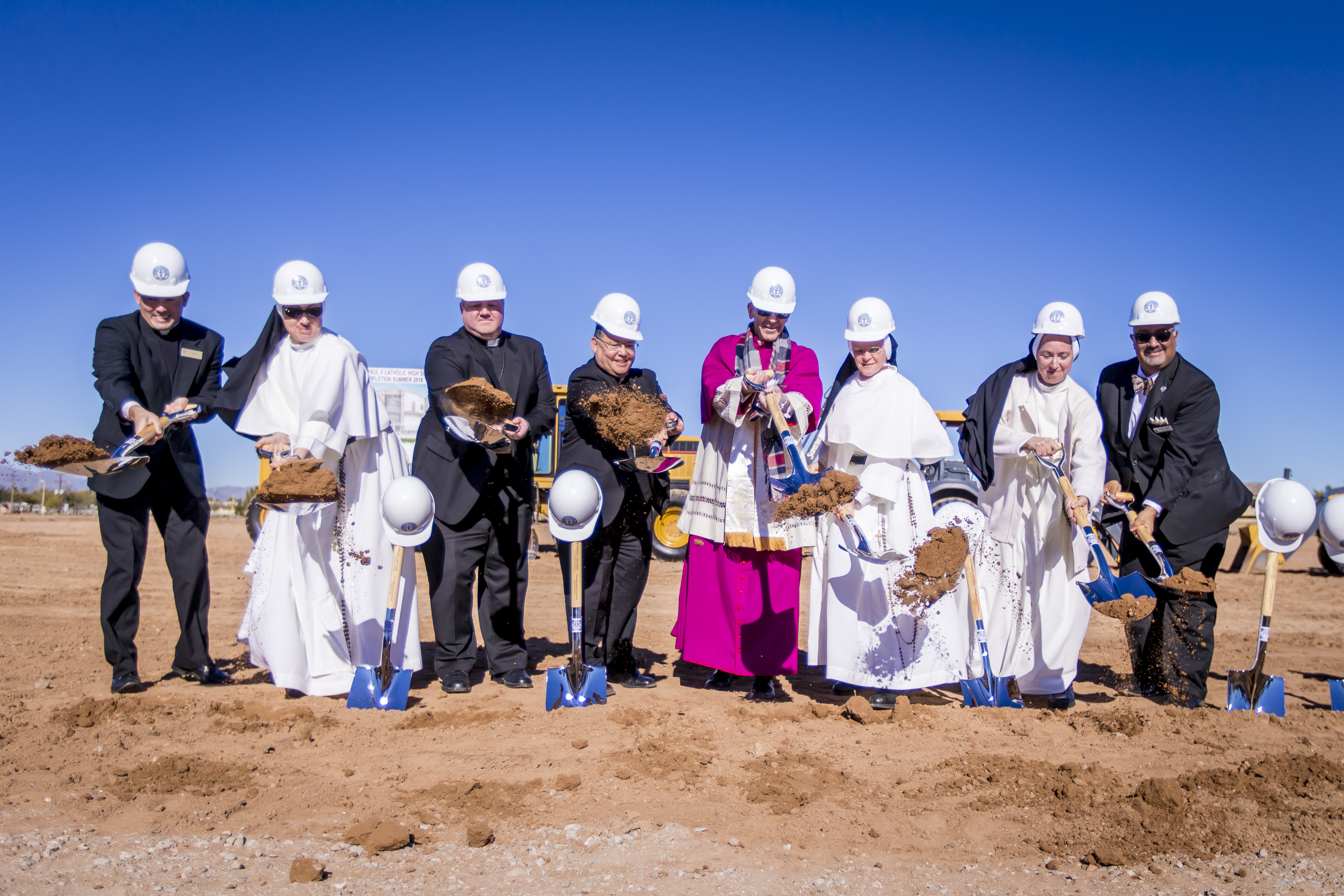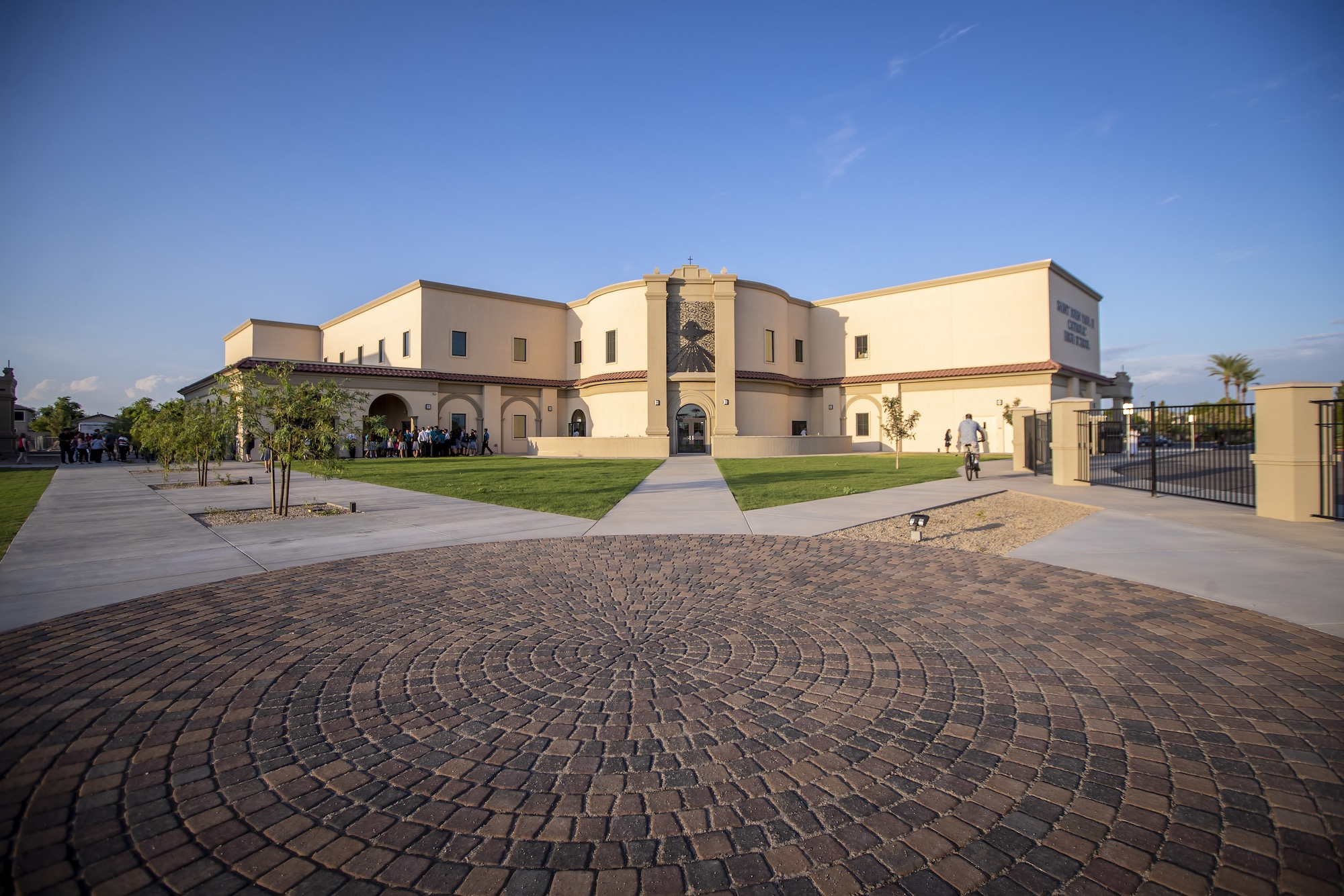AVONDALE — A visitor to St. John Paul II Catholic High School can sense the genuine enthusiasm mixed with a feeling of purpose and focus as students greet one another in the hallways or smile and cheerfully acknowledge faculty and staff.
St. John Paul II is not just another school that has launched into on-site learning as the United States pushes toward emerging from the COVID-19 pandemic.
A little over 4 years ago, Diocese of Phoenix dignitaries and the Dominican Sisters of St. Cecilia were breaking ground on a vacant tract of land near Thomas and Litchfield roads that would become the diocese’s newest high school — and its first in the expanding West Valley. The doors opened about a year and a half later, in August 2018.
Soon, 37 seniors will become St. John Paul II’s first graduates.

An evening Mass will be celebrated next door at St. Thomas Aquinas Parish May 13, and the graduation will take place at 10 a.m. the next day.
“(This) is something the entire diocese can rejoice in,” said Sr. Mary Jordan Hoover, O.P., the school’s principal. “This graduation marks the success of our (discipleship and evangelization) campaign, ‘Together, Let Us Go Forth.’ It shows the school has met this milestone and that there will be others in the future. That’s what makes this unique among all the graduations that will take place in the diocese.”
“It is an incredible milestone for the seniors at St. John Paul II and for the school itself,” said Domonic Salce, superintendent for Catholic Schools.
“The (graduation) events may or may not look different due to the pandemic, but it will be something for the seniors, their parents and the school to cherish as the first graduating class,” he said.
Getting to this point was always going to be unique. A brand-new school has no history and no culture from which to draw upon. But that was the attraction for students in the school’s first classes. They would be the ones to create and establish a tradition.
Pandemic year
Added to whatever challenges came from being the school’s pioneers was the COVID-19 outbreak with its restraints and limitations.
“From the beginning of this school year, our goal was to get students back into the classroom as quickly and as safely as possible while providing families options of instructional models as they felt comfortable with,” Salce explained.
St. John Paul II has been teaching in-person, on-site for much of 2021. After the pandemic was declared last year and once the school received clearance, classes were held online. When the school began inviting students back in-person, it reopened gradually. St. John Paul II has several “houses” or sections that students are members of. Those houses were brought back one at a time.
“About 80 percent came back,” said the school’s Director of Admissions and Marketing Matthew Gonzales. “The other 20 percent felt being online would be the best option for them.”
The school did require any student receiving a grade of D or F in one of six core subjects to return to campus for the academic year’s fourth quarter.
“If a student is attending remotely, it’s harder to monitor them. They may be struggling with the self-discipline needed to learn online; and you can’t focus on a kid to make sure his or her attention isn’t on something else,” explained ethics and Latin teacher Tony Leccese.
On campus, the school continues to follow CDC and Arizona Department of Health Services directives, including wearing of masks and 3-foot distancing inside classrooms. “We’ve limited class sizes as best we could. Teachers clean desks between class. To help, we extended the time between classes from 5 to 10 minutes. Facilities staff also clean and disinfect each night,” said Assistant Principal of Student Life & Athletics Arthur Walker, Jr.
Other measures direct students, faculty and staff to use only one side of the hallways to avoid intermingling and individuals clumping up in the corridors; and created two separate lunch periods to allow for social distancing. Schools across the U.S. received help in March when the U.S. Centers for Disease Control (CDC) relaxed its in-classroom guidelines to reduce the 6-foot-distance standard to 3 feet except in common areas, such as school lobbies, and when masks cannot be worn.
Teachers and the administration credited one another for making it work.
“We had an in-service day toward the beginning of year with a speaker about different techniques we can use, such as Flipgrid and Google Classroom. We were trained. The school didn’t just say, ‘You’re online, figure it out’,” said Leccese. Having some students in person while others are online is especially challenging, since a teacher’s attention is split between the two groups, he added.
“The teachers have done an amazing job of staying connected,” said Sr. Mary Jordan. “Our school is not made for online instruction, yet our teachers have risen to the challenge.”
Teachers also thanked parents for their support, patience and flexibility.
“They have been phenomenal. I know it has not been an easy year for parents. Some have had as many as several children at home doing distance learning,” said ethics and bioethics teacher Teresa Morris.
But if the administration, teachers and parents were the pieces that solved the puzzle, the students — especially the seniors — put it all together, experiencing a time that will no doubt prepare them other challenges in life.
“It is a class all of us are proud of. There is so much they have conquered. They took a chance on a new school and shaping what it will be forever. They did not ask to be the class to graduate during a pandemic. It was already going to be a unique day, and it will be additionally unique,” said Morris.
“I’m so excited to send these seniors out,” echoed science teacher and assistant girls soccer coach Meghan Barry. “I love having them in my class, but I can’t wait to see what they do, the change they are going to bring and the light they are going to be in the world and the goodness they will have.”






